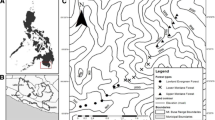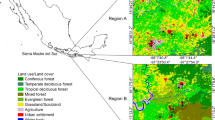Abstract
Many studies investigated the habitat preference and behaviour ecology of individual amphibian species while we know less about how their community assembly reflects changes in environmental factors, including the role of climatic extremes. Community-level studies also allow us to apply trait-based analyses that are crucial for a better understanding of the functioning of amphibian communities and metacommunities. In two years with contrasting rainfall (2012 and 2013), we found amphibian species in 85 different waterbodies of a heterogeneous landscape in Central Europe (Hungary). Within the metacommunity framework, the contributions of local, landscape and spatial variables to community assembly were assessed. We also measured the local extinction–colonisation rates in the ponds for all species between the two years. To investigate the role of dispersal traits in explaining the spatial distribution of species, we studied the relationship between body size and the pure spatial fraction of variation. According to our results, the main drivers were the same in both the dry and wet year, but their relative contribution changed. Local variables played a predominant role in the assembly of the amphibian metacommunity. Spatial signals were more evident in the dry year. This implies not only the adverse effect of decreased connectivity due to the drying out of several habitats but also a loss of breeding sites for the studied amphibians. Local colonisation rates were higher in primarily terrestrial species (Hyla arborea, Pelobates fuscus, Bufo bufo) which only visit ponds during breeding. We found a negative relationship between the pure spatial effect and body size, suggesting an increased level of dispersal limitation in small-bodied species. Our results showed that while the strength and relative role of local and spatial processes changed between years, the role of dispersal traits in explaining the spatial distribution of species was similar. Specialisation to different habitats seems to be a major process in determining vertebrate metacommunities in landscapes. Dispersal traits of different species should be taken more into consideration in the practical conservation of amphibian habitats.





Similar content being viewed by others
References
Babbitt KJ, Baber MJ, Tarr TL (2003) Patterns of larval amphibian distribution along a wetland hydroperiod gradient. Can J Zool 81:1539–1552
Bell G (1977) The life of the smooth newt (Triturus vulgaris) after metamorphosis. Ecol Monogr 47:279–299
Berninghausen F, Berninghausen O (1997) Welche Kaulquappe ist das?: Der wasserfeste Amphibienführer: Heimische Frösche, Kröten, Unken, Molche und Salamander auf 250 Fotos. Naturschutzbund Deutschland, Hannover p 43. Available at: www.whose-tadpole.net
Bonthoux S, Balent G (2015) Bird metacommunity processes remain constant after 25 years of landscape changes. Ecol Complex 21:39–43
Borcard D, Legendre P (2002) All-scale spatial analysis of ecological data by means of principal coordinates of neighbour matrices. Ecol Model 153:51–68
Cayuela H, Besnard A, BéChet A, Devictor V, Olivier A (2012) Reproductive dynamics of three amphibian species in Mediterranean wetlands: the role of local precipitation and hydrological regimes: reproductive dynamics of three amphibian species. Freshw Biol 57:2629–2640
Cottenie K (2005) Integrating environmental and spatial processes in ecological community dynamics. Ecol Lett 8:1175–1182
Curado N, Hartel T, Arntzen JW (2011) Amphibian pond loss as a function of landscape change—a case study over three decades in an agricultural area of northern France. Biol Conserv 144:1610–1618
De Bie T, Brendonck L, Martens K, Goddeeris B, Ercken D, Hampel H et al (2012) Body size and dispersal mode as key traits determining metacommunity structure of aquatic organisms. Ecol Lett 15:740–747
De Meester L, Declerck S, Stoks R, Louette G, Van De Meutter F, De Bie T et al (2005) Ponds and pools as model systems in conservation biology, ecology and evolutionary biology. Aquat Conserv: Mar Freshw Ecosyst 15:715–725
Delatorre M, Cunha N, Raizer J, Ferreira VL (2015) Evidence of stochasticity driving anuran metacommunity structure in the Pantanal wetlands. Freshw Biol 60:2197–2207
Erős T, Sály P, Takács P, Specziár A, Bíró P (2012) Temporal variability in the spatial and environmental determinants of functional metacommunity organization stream fish in a human-modified landscape. Freshw Biol 57:1914–1928
Ficetola GF, De Bernardi F (2004) Amphibians in a human-dominated landscape: the community structure is related to habitat features and isolation. Biol Conserv 119:219–230
Fryer G (1985) Crustacean diversity in relation to the size of water bodies: some facts and problems. Freshw Biol 15:347–361
Google Inc. (2015) Available at: https://www.google.com/earth/
Gibbs JP (1998) Amphibian movements in response to forest edges, roads, and streambeds in southern New England. J Wildl Manage 62:584–589
Gómez-Rodríguez C, Díaz-Paniagua C, Serrano L, Florencio M, Portheault A (2009) Mediterranean temporary ponds as amphibian breeding habitats: the importance of preserving pond networks. Aquat Ecol 43:1179–1191
Gómez-Rodríguez C, Díaz-Paniagua C, Bustamante J, Portheault A, Florencio M (2010) Inter-annual variability in amphibian assemblages: implications for diversity assessment and conservation. Aquat Conserv: Mar Freshw Ecosyst 20:668–677
Hartel T (2008) Movement activity in a Bombina variegata population from a deciduous forested landscape. North-West J Zool 4:79–90
Hartel T, Oellerer K (2009) Local turnover and factors influencing the persistence of amphibians in permanent ponds from the Saxon landscapes of Transylvania. North-West J Zool 5:40–52
Hartel T, Schweiger O, Öllerer K, Cogalniceanu D, Arntzen JW (2010) Amphibian distribution in a traditionally managed rural landscape of Eastern Europe: probing the effect of landscape composition. Biol Conserv 143:1118–1124
Hartel T, Bancila R, Cogalniceanu D (2011) Spatial and temporal variability of aquatic habitat use by amphibians in a hydrologically modified landscape. Freshw Biol 56:2288–2298
Holenweg AK, Reyer HU (2000) Hibernation behavior of Rana lessonae and R. esculenta in their natural habitat. Oecologica 123:41–47
Houlahan JE, Findlay CS, Schmidt BR, Meyer AH, Kuzmin SL (2000) Quantitative evidence for global amphibian population declines. Nature 404:752–755
Jakob C, Poizat G, Veith M, Seitz A, Crivelli AJ (2003) Breeding phenology and larval distrbution of amphibians in a Mediterranean pond network with unpredictable hidrology. Hydrobiologia 499:51–61
Jenkins DG, Brescacin CR, Duxbury CV, Elliott JA, Evans JA, Grablow KR, Hillegass M, Lyon BN, Metzger GA, Olandese ML, Pepe D, Silvers GA, Suresch HN, Thompson TN, Trexler CM, Williams GE, Williams NC, Williams SE (2007) Does size matter for dispersal distance? Glob Ecol Biogeogr 16:415–425
Knutson MG, Sauer JR, Olsen DA, Mossman MJ, Hemesath LM, Lannoo MJ (1999) Effects of landscape composition and wetland fragmentation on frog and toad abundance and species richness in Iowa and Wisconsin, USA. Conserv Biol 13:1437–1446
Kovar R, Brabek M, Vikta R, Bocek R (2009) Spring migration distances of some Central European amphibian species. Amphibia-Reptilia 30:367–378
Laan R, Verboom B (1990) Effects of pool size and isolation on amphibian communities. Biol Conserv 54:251–262
Lehtinen RM, Galatowitsch SM, Tester JR (1999) Consequences of habitat loss and fragmentation for wetland amphibian assemblages. Wetlands 19:1–12
Leibold MA, Holyoak M, Mouquet N, Amarasekare P, Chase JM, Hoopes MF et al (2004) The metacommunity concept: a framework for multi-scale community ecology. Ecol Lett 7:601–613
Logue JB, Mouquet N, Peter H, Hillebrand H (2011) Empirical approaches to metacommunities: a review and comparison with theory. Trends Ecol Evol 26:482–491
Marsh DM, Trenham PC (2001) Metapopulation dynamics and amphibian conservation. Conserv Biol 15:40–49
Németh A, Flórián N, Kavecsánszki A (2012) Kétéltűmentés a 311-es közút farmosi szakaszán. Természetvédelem és kutatás a Tápió-vidéken, Rosalia 7
Oertli B, Joye DA, Castella E, Juge R, Cambin D, Lachavanne JB (2002) Does size matter? The relationship between pond area and biodiversity. Biol Conserv 104:59–70
Oksanen J, Blanchet FG, Kindt R, Legendre P, Minchin PR, O’Hara RB, Simpson GL, Solymos P, Stevens MHH, Wagner H (2012) vegan: Community Ecology Package. R package version 2.0
OMSZ (2014) Avaliable at: http://www.met.hu/en
Pechmann JH, Estes RA, Scott DE, Gibbons JW (2001) Amphibian colonization and use of ponds created for trial mitigation of wetland loss. Wetlands 21:93–111
Provete DB, Gonçalves-Souza T, Garey MV, Martins IA, Rossa-Feres DC (2014) Broad-scale spatial patterns of pond morphology and canopy cover affect the structure of Neotropical tadpole metacommunity. Hydrobiologia 734:69–79
Puky M, Schád P, Szövényi G (2005) Herpetological atlas of Hungary. Varangy Akciócsoport Egyesület, Budapest
R Development Core Team (2009) R: a language and environment for statistical computing. R Foundation for Statistical Computing, Vienna, Austria. Available at: http://www.R-project.org/
Rannap R, Lohmus A, Briggs L (2010) Restoring ponds for amphibians: a success story. Pond Conserv Eur 210:243–251
Richter-Boix A, Llorente GA, Montori A (2007) Structure and dynamics of an amphibian metacommunity in two regions. J Anim Ecol 76:607–618
Rubbo MJ, Kiesecker JM (2005) Amphibian breeding distribution in an urbanized landscape. Conserv Biol 19:504–511
Schwartz SS, Jenkins DG (2000) Temporary aquatic habitats: constraints and opportunities. Aquat Ecol 34:3–8
Semlitsch RD (ed) (2003) Amphibian conservation. Smithsonian Books, Washington
Semlitsch RD (2008) Differentiating migration and dispersal processes for pond-breeding amphibians. J Wildl Manage 72:260–267
Shurin JB, Cottenie K, Hillebrand H (2009) Spatial autocorrelation and dispersal limitation in freshwater organisms. Oecologia 159:151–159
Sinsch U (1988) Seasonal changes in the migratory behaviour of the toad Bufo bufo: direction and magnitude of movements. Oecologia 76:390–398
Skelly DK (2001) Distributions of pond-breeding anurans: an overview of mechanisms. Isr J Zool 47:313–332
Skelly DK, Freidenburg LK, Kiesecker JM (2002) Forest canopy and the performance of larval amphibians. Ecology 83:983–992
Smith MA, Green DM (2005) Dispersal and the metapopulation paradigm in amphibian ecology and conservation: are all amphibian populations metapopulations? Ecography 28:110–128
Smith MA, Green DM (2006) Sex, isolation and fidelity: unbiased long-distance dispersal in a terrestrial amphibian. Ecography 29:649–658
Snodgrass JW, Komoroski MJ, Bryan AL, Burger J (2000) Relationships among isolated wetland size, hydroperiod, and amphibian species richness: implications for wetland regulations. Conserv Biol 14:414–419
Soininen J, Lennon JJ, Hillebrand H (2007) A multivariate analysis of beta diversity across organisms and environments. Ecology 88:2830–2838
Strijbosch H (1979) Habitat selection of amphibians during their aquatic phase. Oikos 33:363–372
Stuart SN, Chanson JS, Cox NA, Young BE, Rodrigues AS, Fischman DL et al (2004) Status and trends of amphibian declines and extinctions worldwide. Science 306:1783–1786
Vági B, Kovács T, Bancila R, Hartel T, Anthony B (2013) A landscape-level study on the breeding site characteristics of ten amphibian species in Central Europe. Amphib-Reptil 34:63–73
Vagvolgyi J (1975) Body size, aerial dispersal, and origin of the Pacific land snail. Fauna Syst Zool 24:465–488
Van Buskirk J (2005) Local and landscape influence on amphibian occurrence and abundance. Ecology 86:1936–1947
Venables W, Ripley YB (2002) Modern applied statistics using S. Springer, New York
Vos CC, Chardon JP (1998) Effects of habitat fragmentation and road density on the distribution pattern of the moor frog Rana arvalis. J Appl Ecol 35:44–56
Welborn GA, Skelly DK, Werner EE (1996) Mechanisms creating community structure across a freshwater habitat gradient. Annu Rev Ecol Syst 27:337–363
Werner EE, Skelly DK, Relyea RA, Yurewicz KL (2007a) Amphibian species richness across environmental gradients. Oikos 116:1697–1712
Werner EE, Yurewicz KL, Skelly DK, Relyea RA (2007b) Turnover in an amphibian metacommunity: the role of local and regional factors. Oikos 116:1713–1725
Weyrauch SL, Grubb TC Jr (2004) Patch and landscape characteristics associated with the distribution of woodland amphibians in an agricultural fragmented landscape: an information-theoretic approach. Biol Conserv 115:443–450
Wilbur HM (1980) Complex life cycles. Annu Rev Ecol Syst 11:67–93
Acknowledgments
We are grateful to Piet Spaak and four anonymous reviewers for providing useful comments and suggestions. We thank David Kurz and Dunja Lukić for the language revision. The research stay of A. L. Péntek at WasserCluster Lunz was supported by the short-term study program scholarship of Campus Hungary.
Author information
Authors and Affiliations
Corresponding author
Additional information
Handling Editor: Piet Spaak.
Electronic supplementary material
Below is the link to the electronic supplementary material.
Rights and permissions
About this article
Cite this article
Péntek, A.L., Vad, C.F., Zsuga, K. et al. Metacommunity dynamics of amphibians in years with differing rainfall. Aquat Ecol 51, 45–57 (2017). https://doi.org/10.1007/s10452-016-9597-9
Received:
Accepted:
Published:
Issue Date:
DOI: https://doi.org/10.1007/s10452-016-9597-9




